Spring Is On Its Way
Posted on Thursday, March 13, 2025 · Leave a Comment
Here in Cornish Flat, this seems like an old fashioned winter. Temperatures have been consistently below freezing, and the ground has had at least a light covering of snow most of the time. No deep snow, the kind that insulates the ground and keeps tender perennials safe, but enough to sooth the eyes when looking at the landscape.
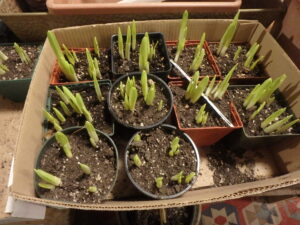
I planted these mini-daffodils last November and they are ready to bloom on a sunny windowsill.
But we gardeners are already thinking of spring. Fortunately, I planted many small pots of Tête-à-tête daffodils last fall, and stored them in my basement which stays at 40 degrees. The foliage is up now, and their roots are pushing though the holes in the bottom of the pots, so I know they are ready to bring up to the warmth of the house. I’ve been putting them in sunny windowsills, and many are blooming – and ready to give away. For me, this is a spring ritual: giving 4-inch pots of flowers to friends and neighbors.
If you are hungering for spring, you might consider going to a spring flower show. Unfortunately, many of spring shows have given up. Boston no longer has its extravaganza, so the Connecticut show in Hartford is now New England’s big event. It has many nice displays and many great classes to attend. This year it is February 20 to 23.
Then there is one of my favorites, the Vermont Flower Show in Essex Junction, Vermont on March 7 to 9. It’s small enough to see everything in one day, but has lots to offer.
In Rhode Island there is the Home Show from April 10 to 13, and it has a flower and garden portion, though I have not been down to Providence since the big flower show folded its tent in 2016.
For the travel-inclined there is the Philadelphia show, March 1 to 9. It was has been a spring tonic since1829. The poinsettia was introduced to American gardeners at that first show, and Ben Franklin may have attended that year. Go on a weekday for smaller crowds, and be prepared to spend a lot – but to have a lot of fun.
February is the month I go through my seed packets to see what I need to buy. Most vegetables and flowers stay viable for 3 years. Exceptions to that rule are all onion-family seeds and parsnips, so I buy them each year. I’ve found that shallots do very well for me and keep longer than onions in the winter, so I will buy new seeds and plant them indoors and keep under lights starting in early March. Peppers of all sorts need a long time to get big enough to plant outdoors, so I also start them in March. Tomatoes I start in April, usually around the 10th.
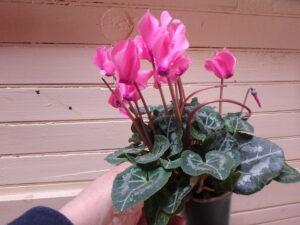
This Cyclamen will bloom for 8 weeks or more in a low light, cool spot
This is also the time of year to pay attention to your houseplants. The days are getting longer, roots and shoots are growing, and they need more water. If you are trying to overwinter a rosemary plant, double the water it gets. A fully dry rosemary is a dead rosemary, and late February or early March is the time of year most of us kill ours. I admit to failing with rosemary by keeping to my weekly watering schedule.
If you have the mid-winter blues, buy yourself some nice cut flowers at your local florist. I prefer buy from a florist, as they generally take better care of their flowers than big box grocery stores. Many years ago I went to the Boston flower market –leaving at 5am – with a friend who owned a florist shop to buy flowers for her shop. The flower market was the size of a football field and had every kind of flower you could imagine. What fun that was!
Some years ago the flower trade got a bad reputation because many of the flowers came from Colombia, South America, where the growers used pesticides liberally and paid their workers a pittance. But I believe that now many flowers in winter are grown in the States and done so with environmentally sound practices. You can always ask your florist where their flowers come from.
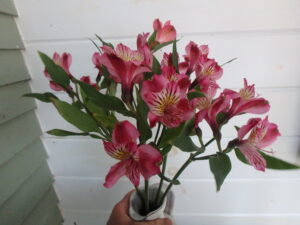
Alstormeria is a long lasting inexpensive cut flower
If you want cut flowers that last a long time in a vase, try alstromeria or lisianthus. Both hold up very well. Also excellent are chrysanthemums, asters, sea lavender and bells of Ireland.
Then there are a couple of gorgeous potted flowers that bloom for a longtime at this time of year: cyclamen and Phalaenopsis orchids. The key to these is to minimize watering and to keep them out of direct sunlight. The cyclamen are cheap enough that you can compost them when they are done booming (in 8 to 10 weeks). Phalaenopsis orchids are more expensive but can be saved from year to year.
Lastly, this is a good time of year to think about your outdoor gardens and how you can improve them, come spring or summer. Start by looking out your favorite window. What do you see now that gives you joy? If you only grow flowers, the landscape is bleak.
Think about trees, shrubs and decorative grasses that you could add to the landscape. Would a nice miniature or weeping conifer fit into a perennial bed? A Merrill magnolia in the middle of your lawn could offer a nice shape and buds and bark that please you. It will bloom magnificently with large double white blossoms in April. It will give you something to look forward to. And after all, isn’t that part of the reason why we all garden?
Brightening the Dark Days of Winter
Posted on Tuesday, November 30, 2021 · Leave a Comment
This is the darkest time of the year: not only are the days short, clouds obscure the sun much of the time. Many of us find the gloom oppressive, especially when there is neither enough snow to ski, nor ice to skate on. And for gardeners, there is little we can (or wish to) do outside. So what do I do?
First, I go to my local grocery store or florist and buy cut flowers or potted plants. For $10 or $15 I can brighten my outlook considerably. The most economical to buy are potted plants. They will, with a minimum of care and forethought, bloom for weeks – or even for months. Here are a few of my favorites:
Christmas cactus. It should be called a Thanksgiving cactus, really, because they usually bloom well before Christmas. Buy one in full bloom, or that has a mix of blossoms and buds. They need moderate light indoors, but not hot afternoon sun. Temperatures of 60 to 70 degrees are best for success. They should not be allowed to dry out completely, but neither do they want to be kept soggy. They like humidity, so place them in a saucer of small stones and add water. Never let the pot sit in water.
Cyclamen. Another low-light plant. This one suited for even less light than Christmas cactus. If you give it any direct sunshine, an hour or two of morning sun is plenty, but indirect light is better.
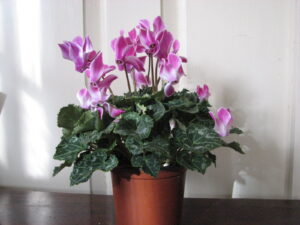
Cyclamen really are not fussy, and bloom for weeks
Water your cyclamen only when dry, which depends on the temperature and relative humidity. I find picking up the pot tells me a lot: if dry, it weighs very little, when moist, it is heavier. If you go too long, the flowers will flop as if to say, “Look at me, I’m dying of thirst!” But they recover quickly. Place your plant in a saucer of water and let it suck up water. But don’t let it sit in water for long.
My mother loved African violets, and did well with them. I remember doing an experiment with my new Chemistry Set for Young Scientists when I was in the fourth grade. I made a solution of tannic acid, and put a drop on a leaf. Overnight, it burned a perfect hole! Great experiment until my mother asked me if I had done something to her plant.
I have not had great luck with African violets here in New Hampshire (they may have heard about my experiment, way back when). I largely heat with a wood stove, and keep the house warm, but quite cool at night. I finally read an article that said one should never let the temperature in the room they are in drop below 70 degrees. So I no longer try, though I have recently read that temps down to 60 degrees are okay.
If you want to grow them, keep them consistently warm in a bright room but not in direct sunshine. They like high humidity (hence do not like woodstoves) but do not tolerate soggy roots. Water from the bottom, but water once a month from above (to flush out any fertilizer salts). Never let water get on the leaves. Pinch off spent blossoms or yellowed leaves.
My absolute favorite house plant is an orchid called Phalaenopsis or moth orchid. Buy them in bloom, and they will bloom for many weeks. Direct sunlight can scorch the leaves, but they need a bright room. These are tropical orchids so like warm temperatures. But cool nights are good – down to 55 degrees.
Moth orchids in their native environment grow in trees. So the soil mix they come in is generally a special orchid mix made of bark chips, and perhaps a little perlite or vermiculite. This mix allows water to run right through it. Be sure that if it comes with an inner pot and an outer pot, to pour out water after watering from the outer pot, which normally has no drainage. Or just lift the inner pot and run water through in your sink. Otherwise you will kill your orchid. Water once a week, or if exposed roots turn silvery white.
According to the experts, tree orchids such as these do best with good air circulation. Me? I find that in a room with people coming and going there is enough air movement to keep them healthy. I do grow them over a saucer of pebbles and water to increase humidity, and grow them in the bathroom where steam from the shower helps.
But if you have no patience with house plants, or believe you cannot grow them, buy flowers for a vase. Most cut flowers will last a week in a vase, many will last longer. Most stems cost between $1.50 and $3.00. Buy an odd number of stems – 3, 5, 7 or 11, depending on your budget.
The vase for displaying cut flowers should be about half as tall as the stems are long (or a little less). But that rule is not firm. If the arrangement looks good to your eye, it is fine. Use a clean glass or pottery vase for best results, but if you want to use Grandma’s silver vase, go ahead. Elegance is good.
Cut flowers generally come with a little packet of white powder. Use it. It helps to keep the water from getting full of bacteria or fungus that will clog the stem, keeping it from taking up water. Pull off any leaves that would otherwise go in the water. You can also use a teaspoon of Clorox in a quart of water. Never put cut flowers near a radiator or wood stove.
So buy something in bloom. It will help to dissipate the gloom of short, dark days. Oh, and about that African violet: I confessed, and did not get punished. But I never experimented with her houseplants again.
Henry’s book “
Organic Gardening (not just) in the Northeast” is available from him for $19. Mail a check to Henry Homeyer at PO Box 364, Cornish Flat, NH 03746, or order from his website,
www.Gardening-Guy.com.
Four Great Plants to Brighten Up Your House
Posted on Sunday, February 5, 2017 · Leave a Comment
Winter is tough on many gardeners, myself included. We need flowers blooming and plants to tend. But many of us are not enthralled with standard houseplants because they are often fussy and, if over-watered, too easy to kill. Let me suggest some nice easy, disposable flowers you can get at your local nursery or food coop.
I recently bought 3 blooming primroses for a total of $11.85. One is purple, the others shades of pink. They will bloom for a couple of weeks – or perhaps more. The tags only said ”Primula” (its scientific genus) and “Plant in part shade 8” apart”. The tag did not say, however, if these primroses would survive a New England winter. I suspect not, having babied other grocery store primroses along until the ground thawed and planted them outside. But I don’t care. These lovely plants will provide color and life indoors at a drab time of the year. And for less than $4 each, they don’t have to last forever.
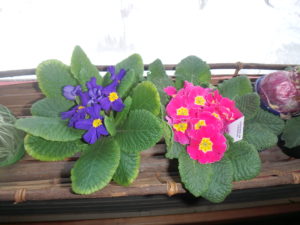
Primrose
What the tag should have said, however, is “Do not keep this primrose in a hot, sunny window unless you are willing to water regularly.” The soil they are in dries out fast, and you can cook a primrose – and most other grocery store plants – in just a day or two of inattention. I did that recently, but I placed the abused primrose in a deep dish and filled it with water, allowing it to suck up plenty. And it recovered in just a few hours.
I usually add a few drops of a product called “Superthrive” to the water when I have a plant that is suffering from neglect. This liquid contains plant hormones and seaweed extracts, and is very good for helping plants recover from environmental stress. It is expensive if calculated by the ounce, but so little is needed that it is not expensive. And it works. A 4 ounce bottle costs around $10-12.
I also bought a cyclamen in my effort to brighten up the house and do some attitude adjustment. Cyclamen definitely do not want to be in a sunny window. Bright indirect light is best. They come in a range of pinks, reds, magentas and white. I tell when they need watering by lifting the pot. If it feels very light, it’s time to give it water.
Cyclamen keep on blooming for much longer than primroses, and can last for years, getting bigger and better each year. If you want to learn about getting them to re-bloom, find a copy of Thalassa Cruso’s wonderful book, Making Things Grow: A Practical Guide for the Indoor Gardener. It’s out of print, but readily available. Every used bookstore has copies, and it’s a gem. Ms. Cruso was a TV personality, I gather, and her books read the way she must have presented herself – as a friendly, knowledgeable auntie.
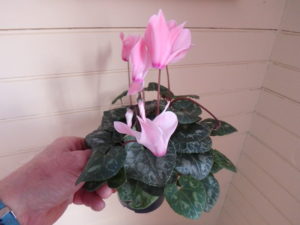
Cyclamen
Thalassa Cruso was, of course, a plant fanatic. I’m not sure that following every bit of her advice is worth the trouble. She notes that cyclamen come originally from Iran where they bloom in winter. She claimed to move hers every evening to a cool spot such as a mudroom where the temperature is below 60 degrees. My goodness, it’s enough for me to turn off all the lights, feed the woodstove and the cat, take out the dog and brush my teeth before going to bed. Now I learn I should be moving the cyclamen, too!
Cineria is another gem available at this time of year. It has the added advantage of a lovely fragrance, too. It appears as a mound of daisy-like flowers that stand up a good 10 inches. It wants bright light, but no direct sunshine (they will finish up too quickly in the sun). Its soil needs to be kept moist, but not soggy.
Cineria are true annuals. That means that once the 6-weeks of blooming is over, the plant is done. You cannot get it to survive, year after year, returning to bloom again. That’s a blessing. You can feel fine about throwing it in the compost. It’s a no-guilt plant.
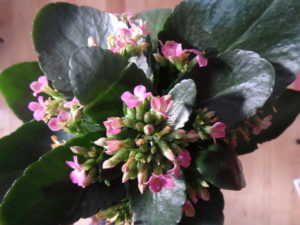
Kalanchoe
The last of my recent investments was a kalanchoe. This is a succulent and does will in warm, dry conditions. It comes in a variety of colors. In Thalassa Cruso’s book it was described in the chapter “Neglectable Plants”. That means, I suppose, it is hard to kill them. This one will, apparently, re-bloom if you cut it back after blooming, and reduce the light for a month, and don’t water it then, either.
So go get some plants in bloom for the house. No matter what you do, they should last longer than the same money invested in cut flowers, so they are a good investment. Just don’t think of them as a lifetime investment and you’ll be happy. Let them bloom, and toss them if you wish. I often do.
Read Henry’s blog twice a week at https://dailyuv.com/gardeningguy His email is henry.homeyer@comcast.net, and he can be reached my snail mail at P.O. Box 364, Cornish Flat, NH 03746.









